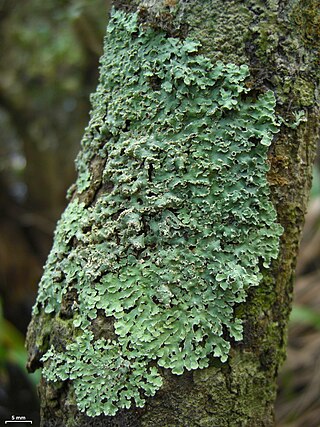
Physcia is a genus of lichen-forming fungi in the family Physciaceae. The widely distributed genus contains about 80 species. The genus is cosmopolitan, and has been extensively studied in various regions in the past several decades, with significant biodiversity in South America identified as a central diversity hotspot. Physcia species are foliose, lobate lichens that grow with a loose to close appressed habit. Their upper surface is typically whitish, pale greenish, green-grey, or dark grey in colour. The thallus colour remains relatively unchanged when moistened. Physcia lichens typically grow on bark, on wood, or rock, although they have occasionally been recorded dwelling on man-made structures. They thrive in nutrient-rich environments and are expanding rapidly in urban areas of the United Kingdom previously affected by SO2 pollution.

Myelochroa is a genus of foliose lichens in the family Parmeliaceae. They are commonly known as axil-bristle lichens. It was created in 1987 to contain species formerly placed in genus Parmelina that had a yellow-orange medulla due to the presence of secalonic acids. Characteristics of the genus include tightly attached thalli with narrow lobes, cilia on the axils, and a rhizinate black lower surface. Chemical characteristics are the production of zeorin and related triterpenoids in the medulla. Myelochroa contains about 30 species, most of which grow on bark. The genus has centres of distribution in Asia and North America.
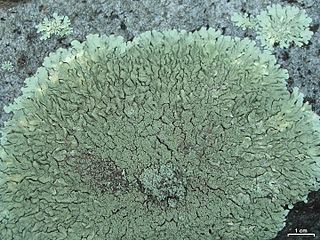
Xanthoparmelia is a genus of foliose lichens in the family Parmeliaceae. This genus of lichen is commonly found in the United States, as well as Australia, New Zealand and Ecuador.

A cephalodium (pl. cephalodia) is a small gall-like structure found in some lichens. They occur only lichens which contain both cyanobacterial and green algal partners. Cephalodia can occur within the tissues of the lichen, or on its upper or lower surface. Lichens with cephalodia can fix nitrogen, and may be an important contributor of nitrogen to the ecosystem.
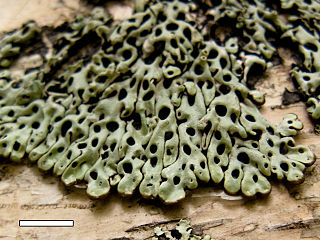
Menegazzia is a genus of lichenized fungi containing roughly 70 accepted species. The group is sometimes referred to as the tree flutes, honeycombed lichens, or hole-punch lichens. The most obvious morphological feature of the genus is the distinctive perforations spread across the upper side of the thallus. This makes the group easy to recognise, even for those not particularly familiar with lichen identification.
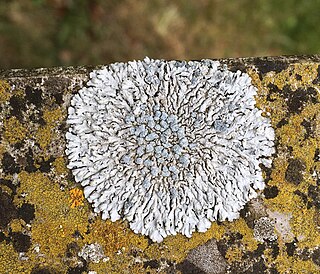
Physcia caesia, known colloquially as blue-gray rosette lichen and powder-back lichen, is a species of foliose lichenized fungus. First described by Georg Franz Hoffmann in 1784, it is common across much of Europe, North America and New Zealand, and more patchily distributed in South America, Asia, Australia and Antarctica. There are 2 subspecies: P. c. caesia and P. c. ventosa, as well as a number of distinct forms and varieties. Molecular studies suggest that the species as currently defined may be polyphyletic. It is typically pale gray shading to darker gray in the center, and grows in a small rosette, usually some 2–3 cm (0.79–1.18 in) across at maturity. It only rarely has apothecia, instead reproducing most often vegetatively via soredia, which are piled in round blue-gray mounds across the thallus's upper surface. It grows most often on rock—principally calcareous, but also basaltic and siliceous—and also occurs on bone, bark and soil. It is nitrophilic and is particularly common on substrates where birds perch.

Cladonia parasitica, commonly known as the fence-rail cladonia, fence-rail cup lichen or parasite club lichen, is a species of fruticose, cup lichen in the family Cladoniaceae. It was first described by Hoffmann in 1784 under the name Lichen parasiticus, until he reclassified it under the genus Cladonia in 1795.
Parmotrema abessinicum is a species of corticolous lichen in the family Parmeliaceae. It has been recorded from Africa, Asia, and Oceania.

David John Galloway, FRSNZ was a biochemist, botanist, and lichenologist.
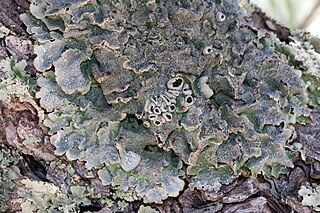
Punctelia hypoleucites, commonly known as the southwestern speckled shield lichen, is a species of foliose (leafy) lichen in the family Parmeliaceae. First formally described by Finnish botanist William Nylander as a species of Parmelia, it was transferred to the genus Punctelia in 1982. The lichen is found in Africa, North America, and South America, where it grows on the bark of both hardwood and coniferous trees. Its greenish-grey thallus is covered with tiny white pseudocyphellae – minute holes in the thallus surface that facilitate gas exchange. Some macroscopic features that help distinguish this species from other related members of the genus include the presence and the structure of the apothecia, the absence of asexual surface propagules, and the light brown color of the thallus undersurface. Chemically, the presence of lecanoric acid in the medulla and atranorin in the cortex help distinguish it from lookalikes.

Punctelia bolliana, the eastern speckled shield lichen, is a species of foliose lichen in the family Parmeliaceae. It is found in North America, with a distribution extending from the Canadian province of Ontario south to the central and northeastern United States and Mexico. It grows on the bark of both deciduous trees and coniferous trees. The combination of characteristics that distinguishes this species from others in genus Punctelia are the absence of the vegetative propagules isidia and soralia, a pale brown lower thallus surface, and the presence of the secondary chemical protolichesterinic acid in the medulla.

Punctelia borreri is a species of foliose lichen in the family Parmeliaceae. It is a common and widely distributed species, occurring in tropical, subtropical, and temperate regions of Africa, Asia, Europe, North America, Oceania, and South America. The lichen typically grows on bark of deciduous trees, and less commonly on rock. Some European countries have reported increases in the geographic range or regional frequency of the lichen in recent decades, attributed alternatively to a reduction of atmospheric sulphur dioxide levels or an increase in temperatures resulting from climate change.

Placidium arboreum, commonly known as the tree stipplescale, is a species of corticolous (bark-dwelling), squamulose (scaley) lichen in the family Verrucariaceae. Placidium arboreum is primarily found in the southeastern United States, but it also has occurrences in the western and northeastern United States, Mexico, the West Indies, Argentina, and Ontario, Canada. In its habitat, it typically grows at the base of hardwood trees, particularly oak species, and can occasionally be found on other tree genera or even over mosses on limestone. Its preferred substrate is the bark of oak trees, and the lichen usually establishes itself in bark crevices.

Dirinaria applanata is a species of corticolous (bark-dwelling), foliose lichen in the family Caliciaceae. It has a wide distribution in tropical and subtropical areas of the world.
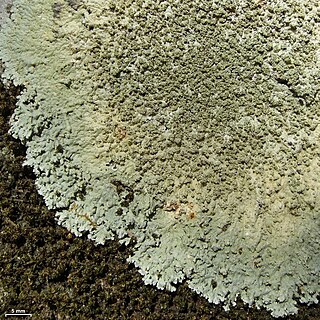
Dirinaria aegialita is a species of foliose lichen in the family Caliciaceae. It is found in tropical regions around the world, with scattered occurrences in subtropical North America.
Dirinaria neotropica is a species of lichen belonging to the genus Dirinaria within the family Caliciaceae. It was described by Kalb in 2004.

Dirinaria confluens is a species of foliose lichen belonging to the genus Dirinaria within the family Caliciaceae. It was originally described by D.D.Awasthi in 1975.

Dirinaria confusa is a species of fungus within the family Caliciaceae, belonging to the order Caliciales in the class Lecanoromycetes of the division Ascomycota.
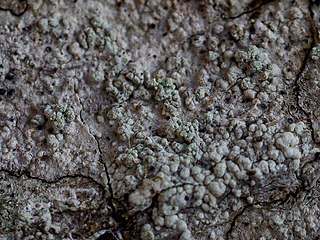
Buellia griseovirens is a species of lichen belonging to the family Caliciaceae. It exhibits a crustose growth type and is commonly found on well-lit, smooth bark, and worked timber surfaces. The species can tolerate moderate pollution.

















